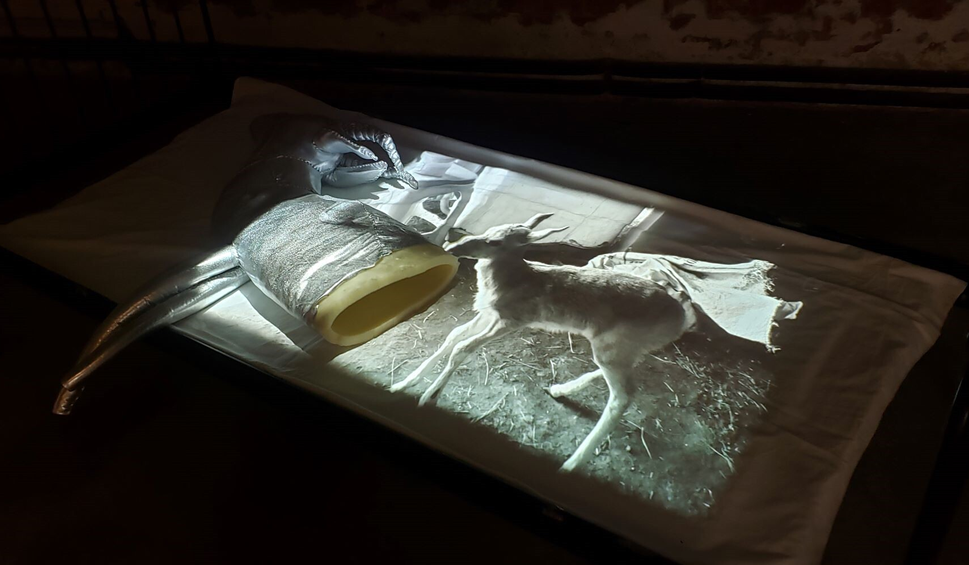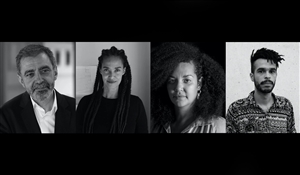Mythological Culture; The Visual Theme of the Mongolian Pavilion at the Venice Biennale 2022
28 Aug 2022The 59th edition of the Venice Biennale is currently being held in Italy, and many artists from all over the world have gathered for this important international event. The wide and serious participation of artists in the booths representing a part of the art history and culture of their country is one of the most prominent features of this event. The background of artworks is a vital part of their formation, and the geography and culture of each land are an inseparable part of the context in which the works are produced. The Mongolian pavilion is one of these prominent examples, and its audience is watching the art that came out of the heart of a mythological culture. After the 59th edition of the Venice Biennale, this is the fourth edition in which Mongolia has participated independently.

View of A Journey Through Vulnerability | Mongolian Pavilion at the Venice Biennale, 2022 | Room 2: “Pulse of Life”. Cosmic Body & Earth Body Series, 2014-2022 | Soft sculptures and paper works | Photo: Jantsankhorol Erdenebayar | Sourse: www.e-flux.com
"A Journey Through Vulnerability" is the route designed for the Mongolian pavilion at this art event by Gantuya Badamgarav, the curator of the pavilion, for the Mongolian pavilion at this art event. The mentioned journey is not only used as a term by which we define the word "travel"; rather, it is a phrase that is linked to the concept of shamanic transfer. A concept that has deep roots in the nationality and country of Mongolia; a witch-like culture that is also tied to Buddhism in some parts. The executor of this shamanic transfer is an artist named Munkhtsetseg Jalkhaajav, who is known as Mugi in the art world. Fifty-five-year-old Mugi was born in Mongolia and is one of the prominent artists in the contemporary art scene of this country. His artworks are based on the exploration of human complexities, as a small part of a vast whole; works that include media such as painting, sculpture, video art, and performance art, in which the artist explores concepts such as pain, fear, healing, and rebirth. In Mugi's works, which are a reflection of his personal experiences, the attempt to create a link between the visual and the non-visual world is evident. A situation in which he embodies the beings of the other world and presents a redefinition of spirits and myths. Mugi's works are inspired by the historical spirituality and traditional culture of his native country, he creates them in a deeply intuitive and ritualistic manner. By tearing, cutting, reassembling, and collaging, he recounts the fears and pains that originate from his deep inner feelings in a different way.
Each of the visual elements used in his works is a symbol of concepts that establish strong links with the mythological and traditional beliefs of the people of his country; from the bird that symbolizes the pulse of life, fertility, healing, and protection to the female bodies that retell the artist's continuous search for inner strength.

View of A Journey Through Vulnerability | Mongolian Pavilion at the Venice Biennale, 2022 | Room 1: “Dream of Gazelle” | Healing Bed, 2019 | Photo: Gantuya Badamgarav | Sourse: www.e-flux.com
The visual space of Mongolia's pavilion at the Venice Biennale 2022 can be analyzed in three separate parts. The first situation defined by the artist in the entrance hall is called "Dream of Gazelle", which reminds of a warehouse-like space. In this section, the audience is faced with a work that is hung on the wall and a bed that is placed on the floor of the hall; a simple black metal bed with a white sheet on it, on which is placed a soft sculpture of the hollow and unfinished body of a resting gazelle. From the ceiling of the hall, a video is projected onto the bed, depicting black and white scenes of small leaping gazelle movements. It is as if these moments are a fragile dream of the remaining half of the gazelle's body, which is embodied by depicting the animal's growth from the moment it is born. Maybe this is the situation where the artist informs us about the existence of dreams in beings other than humans; sleep and dreams are not exclusive to humans, and even a gazelle can dream as much as humans and explore its innermost thoughts in his dreams.
In the second hall, which is defined as the "Pulse of Life", a delicate reading between human and non-human realms has been formed through hybrid beings with goat-like heads; the concept that Mugi tried to approach with the definition of cosmic bodies that he presented in this hall, a collection of soft figures that have embodied the idea formed in the artist's mind during the last eight years. In the process of creating his cosmic bodies, Mugi was inspired by a Buddhist term called samsara. Samsara refers to the totality that surrounds all living beings and molecules of the world, and each of these beings interacts with this universal totality. Regarding Mugi's subjective idea of defining cosmic bodies, the second hall of the Mongolia pavilion is filled with silver-colored bodies suspended from the ceiling. Spiral and two-headed creatures with scary shadows locating on the narrow border between human and animal beings, and at the same time, they are a reflection of female archetypes. It seems that in the process of creating them, Mugi did an inner exploration and created moments that distanced themselves from human codes and looked inside themselves from an outside cosmic world.

View of A Journey Through Vulnerability | Mongolian Pavilion at the Venice Biennale, 2022 | Room 3: Miscarriage. Keeper Of Protector Bird, 2017 | Photo: Jantsankhorol Erdenebayar | Sourse: www.e-flux.com
In the last hall of this booth, which is called "Miscarriage", Mugi has exhibited a single work entitled "Keeper of Protector Bird". On a red carpet, a statue-like woman is sitting on a wooden chair and holding a big bird on her feet. The large and black wings of this bird cover the entire lower body of the woman like a spider. In the mythology of North Asia, the bird is considered one of the main mythological symbols and a messenger and intercessor being that swings between divine and human dimensions. A creature that has become strong in proportion to the life force and causes healing and rebirth in humans. The guardian of the protective bird is the artist's reference to rituals and traditions in which a blackbird protects women from miscarriage.
The sound of a musical instrument is resonating in these three halls. Jaw harp, which is known as zanburak in Iran. Local magicians in Mongolia use this small metal instrument to communicate with otherworldly beings. In a country where a significant population still tends to a nomadic life, the culture of witches and witchcraft plays a prominent role in the lives of its people.
Mugi himself said in describing his works: "Words such as "healing" and "rebirth" are the keywords to enter my world. Through my work I try to engage with our constant ambition of searching for your inner self and attempts of creating yourself by the idea of “becoming wholesome"."
The beings that Mugi creates are placed in an intermediate world; creatures that are neither included in the definition of human nor have an evolved meaning in the other world. He embodies an aura that is not necessarily meant to be an actual embodiment of it. The creatures hanging from the ceiling can be the result of this artist's viewpoint. Silver sculptures that are both sculptures and are not included in the classical definition of sculpture remain suspended between the ground and the air. Their feet do not reach the shadows on the earth, nor can they break the roof above their heads and ascend to the cosmic world. In one place, like the body of a resting gazelle, they are left on an incomplete bed so that their inner dream spills over a white sheet, and in another situation, they are faced with growing indecision that fails to define a continuous identity.
Sources:
- www.e-flux.com/announcements/467035/munkhtsetseg-jalkhaajava-journey-through-vulnerability
- www.mongolia-pavilion-venice-biennale.com/2022/05/05/in-venice-today-mongolian-pavilion-mongolia-at-59th-biennale-of-art
- www.labiennale.org/en/art/2022/mongolia
- www.976artgallery.com/munkhtsetseg-jalkhaajav
- www.juliet-artmagazine.com/en/a-cosmic-vulnerability-the-mongolian-pavilion-at-the-venice-biennale-2022
Cover and slider image:
- www.e-flux.com






